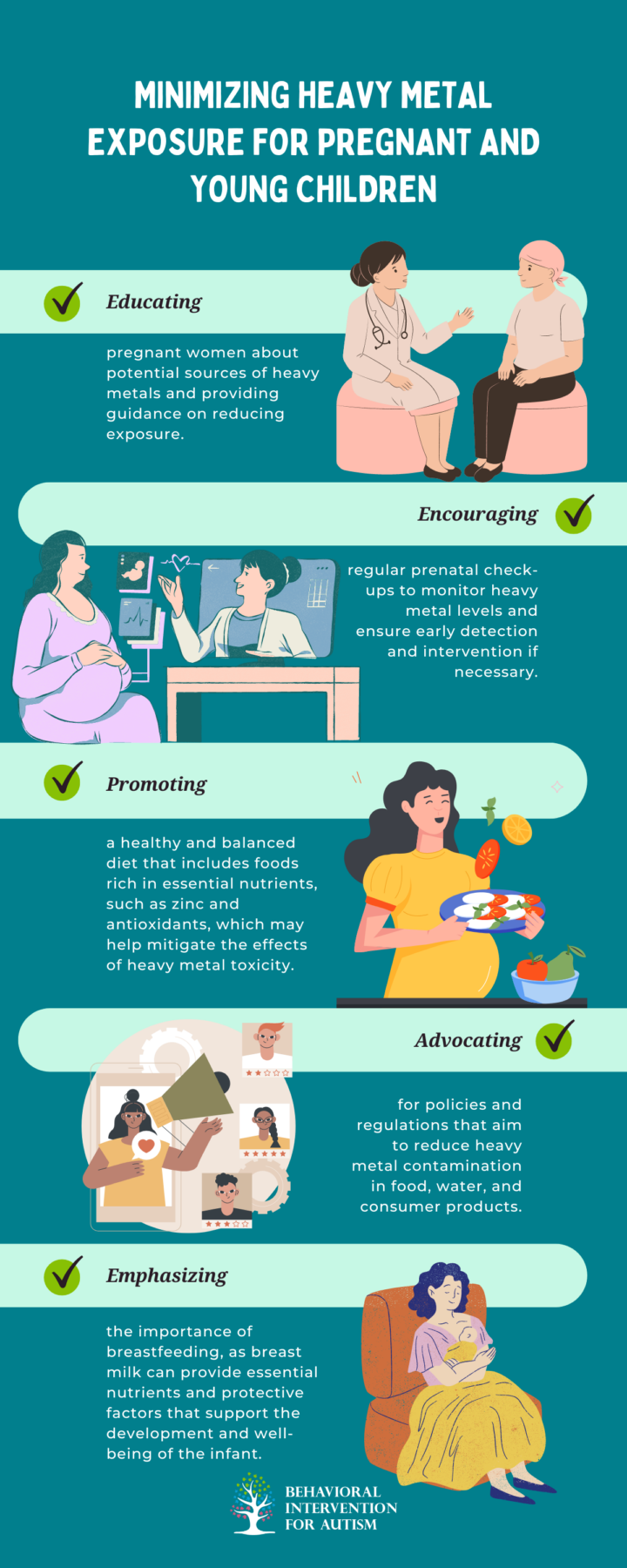
Table of Contents
Understanding the potential link between heavy metals and autism is an important area of research. We’ll examine how metal exposure impacts autistic children and investigate the role heavy metals may play in the development of autism.
Metal Exposure in Autistic Children
Several studies have investigated the levels of heavy metals in autistic children, providing insights into their metal exposure. Higher urinary levels of cadmium (Cd), lead (Pb), and mercury (Hg) have been found in urine and hair samples of autistic children in multiple studies. These findings suggest decreased excretion and a possible high body burden of these metals in individuals with autism.
Furthermore, studies have identified higher levels of arsenic (As), lead (Pb), mercury (Hg), cadmium (Cd), aluminum (Al), tin (Sn), antimony (Sb), barium (Ba), thallium (TI), tungsten (W), and zirconium (Zr) in whole blood, red blood cells (RBC), and hair samples of children with autism compared to the control group. These findings indicate a greater toxic metal exposure in both the short-term and long-term for individuals with autism.
Role of Heavy Metals in Autism Development
The role of heavy metals in the development of autism is a complex and ongoing area of study. Heavy metals have been suggested to play a role in the etiology of autism through epigenetic mechanisms. Research has highlighted potential epigenetic effects of developmental metal exposure on DNA methylation, which is mediated through dysregulation of methyltransferases.
Additionally, exposure to heavy metals during pregnancy has been indicated to be involved in the etiology of autism. Increasing evidence suggests that maternal exposure to heavy metals, even at low-level exposures, can result in an increase in neurodevelopmental disorders. This emphasizes the importance of understanding and addressing potential environmental factors that may contribute to the development of autism.
It is worth noting that the increase in autism diagnosis rates over the past decade may be attributed to heightened awareness, changes in diagnostic standards, and potentially environmental factors. Ongoing research is crucial to further explore the relationship between heavy metals and autism and to develop strategies for managing and reducing metal exposure in individuals with autism.
Understanding metal exposure in autistic children and the potential role of heavy metals in autism development is crucial for researchers and healthcare professionals. This knowledge helps in exploring effective interventions and strategies that prioritize the well-being and health of individuals with autism.
Heavy Metal Toxicity and Autism
Exploring the relationship between heavy metals and autism requires understanding the potential impact of heavy metal toxicity on the defense systems of individuals with autism, as well as the effects of prenatal exposure to these metals.
Impact on Defense Systems
Children with autism often exhibit vulnerabilities in their defense systems against reactive oxygen free radicals and impaired redox homeostasis, similar to what occurs in cases of heavy metal toxicity. This susceptibility to oxidative stress could be attributed to altered glutathione synthesis and impaired antioxidant defense systems.
Oxidative stress occurs when there is an imbalance between the production of free radicals and the body’s ability to neutralize them. In individuals with autism, this imbalance can lead to increased cellular damage and inflammation, potentially contributing to the development and progression of the disorder.
Multiple studies have identified abnormalities in the antioxidant defense systems of individuals with autism, including reduced levels of glutathione, an essential antioxidant. Glutathione plays a crucial role in neutralizing free radicals and protecting cells from oxidative damage. The compromised antioxidant defense systems in individuals with autism may make them more susceptible to the harmful effects of heavy metals.
Effects of Prenatal Exposure
Prenatal exposure to heavy metals has been suggested to play a role in the etiology of autism. Increasing evidence indicates that maternal exposure to heavy metals during pregnancy, even at low levels, can contribute to an increased risk of neurodevelopmental disorders, including autism.
Studies have reported elevated levels of lead, nickel, cadmium, and mercury in autistic children. This early epidemiological data provided the first evidence supporting the hypothesis that prenatal exposure to heavy metals may be a contributing factor in the development of autism.
The mechanisms by which prenatal exposure to heavy metals may impact neurodevelopment are still being investigated. It is believed that heavy metals can disrupt essential developmental processes, interfere with neuronal migration and connectivity, and induce neuroinflammation. These disruptions during critical periods of brain development can potentially result in long-lasting effects on cognitive and behavioral functioning.
Reducing heavy metal exposure, particularly during pregnancy, is crucial for minimizing the potential risk to fetal neurodevelopment. This can involve avoiding sources of heavy metal exposure such as certain foods, contaminated water, and occupational hazards. Pregnant individuals need to consult with healthcare professionals regarding potential heavy metal exposure risks and take appropriate measures to protect themselves and their developing babies.
Understanding the impact of heavy metal toxicity on defense systems and the potential effects of prenatal exposure contributes to our knowledge of the complex relationship between heavy metals and autism. Further research is needed to fully elucidate the mechanisms involved and develop strategies for prevention and intervention.
Zinc Levels in Autism
Zinc, an essential trace element, plays a vital role in various biological processes, including brain development and functioning. In recent years, zinc levels in individuals with Autism Spectrum Disorder (ASD) have garnered significant attention. Let’s explore the link between zinc and autism, including zinc deficiency in individuals with ASD and the potential benefits of zinc supplementation.
Zinc Deficiency in Individuals with ASD
Multiple studies, including meta-analyses, have consistently found a correlation between zinc deficiency and ASD. Most studies report noticeably lower zinc levels in individuals with ASD, particularly in the younger age groups. Zinc deficiency in individuals with ASD has been suggested to contribute to certain symptoms and characteristics associated with the disorder.

Zinc Supplementation Benefits
Research suggests that zinc supplementation may offer potential benefits for individuals with ASD. Studies have shown that zinc supplementation during pregnancy can reduce ASD symptoms in both humans and animal models. These findings support the hypothesis that zinc imbalances may be a cause of ASD rather than a consequence.
While the exact mechanisms underlying the relationship between zinc and ASD are still being investigated, it is believed that zinc’s role in various physiological processes, including neurotransmitter regulation and antioxidant defense, may contribute to its potential therapeutic effects.
It is important to note that zinc supplementation should be approached with caution and under the guidance of healthcare professionals. Proper dosage and monitoring are essential, as excessive zinc intake can lead to adverse effects. Consulting with a healthcare provider can help determine the appropriate dosage and duration of supplementation based on individual needs.
Understanding the connection between zinc levels and ASD provides valuable insights into potential avenues for intervention and support. Further research is needed to fully elucidate the complex relationship between zinc and autism, but the evidence thus far suggests that zinc may play a crucial role in the management and treatment of individuals with ASD.
Geographic Variances in Metal Concentrations
The presence of heavy metals in the environment can vary across different regions, and these variances may have implications for individuals with autism spectrum disorder (ASD). Understanding the metal concentrations in different regions can provide valuable insights into the link between heavy metals and autism.
Metal Concentrations in Different Regions
Research has shown that concentrations of certain heavy metals, including cadmium (Cd), lead (Pb), arsenic (As), and mercury (Hg), were significantly higher in children with Autistic Disorder (ASD) compared to healthy controls. In hair and blood tests, differences in Pb, arsenic, and Hg concentrations were statistically significant (P < 0.05).
Further analysis based on geographic regions revealed interesting findings. In Asia and Europe, ASD patients had higher concentrations of Cd, Pb, arsenic, and Hg compared to healthy controls. The differences in Pb, arsenic, and Hg concentrations were statistically significant (P < 0.05). On the other hand, in North America, healthy controls exhibited higher Cd, arsenic, and Hg concentrations, although statistical significance was not observed (P > 0.05).
The variations in metal concentrations across different regions suggest that environmental factors, such as industrial activities, pollution levels, and dietary habits, may contribute to the differences observed in heavy metal exposure among individuals with ASD.

Implications of Heavy Metal Exposure
The link between heavy metals and autism has significant implications for individuals with autism and their families. Understanding the need to reduce metal exposure and implementing protection measures for vulnerable populations is crucial in managing and mitigating the potential risks associated with heavy metal toxicity.
Need for Reducing Metal Exposure
Reducing metal exposure can help minimize the potential harmful effects that heavy metals may have on neurodevelopment and overall health. Implementing measures to limit exposure to heavy metals in various environments, such as home, school, and community, is essential. This includes adopting practices that reduce exposure to sources of heavy metals, such as contaminated water, air pollution, and certain consumer products.
Furthermore, raising awareness about the potential risks associated with heavy metal exposure and providing education on preventive measures is crucial. This can empower individuals, parents, caregivers, and communities to take proactive steps in reducing metal exposure and creating safer environments for those with autism.
Protection Measures for Vulnerable Populations
Pregnant women and young children are particularly vulnerable to the adverse effects of heavy metal exposure. Maternal exposure to heavy metals during pregnancy has been linked to an increased risk of neurodevelopmental disorders, including autism. Even low-level exposures can have detrimental effects on the developing fetus.
To protect vulnerable populations, it is important to prioritize measures that minimize heavy metal exposure during pregnancy and early childhood. This includes:

Implementing these protection measures can help create an environment that minimizes heavy metal exposure and promotes optimal development and health, particularly for individuals with autism.
To effectively manage the risks associated with heavy metal toxicity in individuals with autism, it’s essential to focus on reducing metal exposure and implementing protective measures. Emphasizing prevention, education, and awareness can help us create a safer and healthier environment for all.
For those seeking tailored support, our team at Behavioral Intervention for Autism is dedicated to providing top-quality ABA therapy in Florida.
Contact us today to learn how our personalized ABA therapy services can make a difference in managing autism-related challenges and enhancing overall well-being.
- 9 Common Obsessions of Children With Autism You Should Know - February 25, 2025
- What is Neurodiversity? A Guide to Embracing Differences - February 25, 2025
- Understanding Hyperfocus in Autism: What It Means and Why It Happens - February 25, 2025
